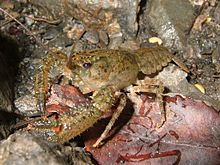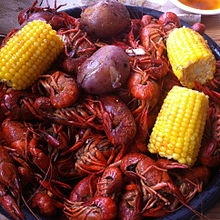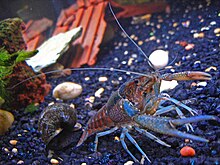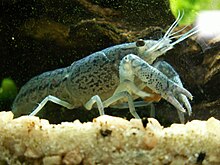Crayfish: Difference between revisions
Pinethicket (talk | contribs) m Reverted edits by 24.196.212.117 (talk) to last version by Addbot |
'''crawdaddy''' |
||
| Line 21: | Line 21: | ||
}} |
}} |
||
'''Crayfish''' – also called '''crawfish''' or '''crawdads''' – are [[freshwater]] [[crustacean]]s resembling small [[lobster]]s, to which they are related; taxonomically, they are members of the [[superfamilies]] '''Astacoidea''' and '''Parastacoidea'''. They breathe through feather-like [[gill]]s and are found in bodies of water that do not freeze to the bottom. They are mostly found in brooks and streams where there is fresh water running, and which have shelter against predators. Most crayfish cannot tolerate [[Water pollution|polluted water]], although some species such as the [[invasive species|invasive]] ''[[Procambarus clarkii]]'' are more hardy. Crayfish feed on living and dead animals and plants.<ref>{{cite book |author=Christoph Needon, Johannes Petermann, Peter Scheffel & Bernd Scheibe |title=Plants and Animals (Pflanzen und Tiere) |publisher=[[Urania Verlag]] |location=Leipzig |year=1971}}</ref> |
'''Crayfish''' – also called '''crawfish''' or '''crawdads''' or '''crawdaddy''' – are [[freshwater]] [[crustacean]]s resembling small [[lobster]]s, to which they are related; taxonomically, they are members of the [[superfamilies]] '''Astacoidea''' and '''Parastacoidea'''. They breathe through feather-like [[gill]]s and are found in bodies of water that do not freeze to the bottom. They are mostly found in brooks and streams where there is fresh water running, and which have shelter against predators. Most crayfish cannot tolerate [[Water pollution|polluted water]], although some species such as the [[invasive species|invasive]] ''[[Procambarus clarkii]]'' are more hardy. Crayfish feed on living and dead animals and plants.<ref>{{cite book |author=Christoph Needon, Johannes Petermann, Peter Scheffel & Bernd Scheibe |title=Plants and Animals (Pflanzen und Tiere) |publisher=[[Urania Verlag]] |location=Leipzig |year=1971}}</ref> |
||
In [[Australia]], [[New Zealand]] and [[South Africa]], the term ''crayfish'' or ''cray'' generally refers to a saltwater [[spiny lobster]], of the genus ''[[Jasus]]'' that is indigenous to much of southern [[Oceania]],<ref>{{cite journal |doi=10.1163/156854065X00613 |title=Let's call the spiny lobster "spiny lobster" |author=Harold W. Sims Jr. |journal=[[Crustaceana]] |volume=8 |issue=1 |year=1965 |pages=109–110 |jstor=20102626}}</ref> while the [[freshwater]] species are usually called ''[[Common yabby|yabby]]'' or ''{{lang|mi|[[Paranephrops|kōura]]}}'', from the [[Indigenous Australian languages|indigenous Australian]] and [[Māori language|Māori]] names for the animal respectively, or by other names specific to each species. An exception is the freshwater [[Murray crayfish]], which belongs to the family [[Parastacidae]] and is found on Australia's [[Murray River]]. |
In [[Australia]], [[New Zealand]] and [[South Africa]], the term ''crayfish'' or ''cray'' generally refers to a saltwater [[spiny lobster]], of the genus ''[[Jasus]]'' that is indigenous to much of southern [[Oceania]],<ref>{{cite journal |doi=10.1163/156854065X00613 |title=Let's call the spiny lobster "spiny lobster" |author=Harold W. Sims Jr. |journal=[[Crustaceana]] |volume=8 |issue=1 |year=1965 |pages=109–110 |jstor=20102626}}</ref> while the [[freshwater]] species are usually called ''[[Common yabby|yabby]]'' or ''{{lang|mi|[[Paranephrops|kōura]]}}'', from the [[Indigenous Australian languages|indigenous Australian]] and [[Māori language|Māori]] names for the animal respectively, or by other names specific to each species. An exception is the freshwater [[Murray crayfish]], which belongs to the family [[Parastacidae]] and is found on Australia's [[Murray River]]. |
||
Revision as of 19:34, 2 March 2013
| Crayfish Temporal range:
| |
|---|---|

| |
| Northern kōura, Paranephrops planifrons (Parastacidae) | |
| Scientific classification | |
| Kingdom: | |
| Phylum: | |
| Subphylum: | |
| Class: | |
| Order: | |
| Suborder: | |
| Infraorder: | |
| Superfamily: | |
| Families | |
| |
Crayfish – also called crawfish or crawdads or crawdaddy – are freshwater crustaceans resembling small lobsters, to which they are related; taxonomically, they are members of the superfamilies Astacoidea and Parastacoidea. They breathe through feather-like gills and are found in bodies of water that do not freeze to the bottom. They are mostly found in brooks and streams where there is fresh water running, and which have shelter against predators. Most crayfish cannot tolerate polluted water, although some species such as the invasive Procambarus clarkii are more hardy. Crayfish feed on living and dead animals and plants.[1]
In Australia, New Zealand and South Africa, the term crayfish or cray generally refers to a saltwater spiny lobster, of the genus Jasus that is indigenous to much of southern Oceania,[2] while the freshwater species are usually called yabby or kōura, from the indigenous Australian and Māori names for the animal respectively, or by other names specific to each species. An exception is the freshwater Murray crayfish, which belongs to the family Parastacidae and is found on Australia's Murray River.
Names
The name "crayfish" comes from the Old French word escrevisse (Modern French écrevisse).[3] The word has been modified to "crayfish" by association with "fish" (folk etymology).[3] The largely American variant "crawfish" is similarly derived.[3]
Some kinds of crayfish are known locally as lobsters, crawdads,[4] mudbugs,[4] and yabbies. In the Eastern United States, "crayfish" is more common in the north, while "crawdad" is heard more in central and southwestern regions, and "crawfish" further south, although there are considerable overlaps.[5]
The study of crayfish is called astacology.[6]
Anatomy
The body of a decapod crustacean, such as a crab, lobster, or prawn, is made up of twenty body segments grouped into two main body parts, the cephalothorax and the abdomen. Each segment may possess one pair of appendages, although in various groups these may be reduced or missing. On average, crayfish grow to 17.5 centimetres (6.9 in) in length, but some grow larger.
Geographical distribution and classification
There are three families of crayfish, two in the Northern Hemisphere and one in the Southern Hemisphere. The Southern-Hemisphere (Gondwana-distributed) family Parastacidae lives in South America, Madagascar and Australasia, and is distinguished by the lack of the first pair of pleopods.[7] Of the other two families, members of the Astacidae live in western Eurasia and western North America and members of the family Cambaridae live in eastern Asia and eastern North America.
Madagascar has an endemic genus, Astacoides, containing seven species.[8]
Europe is home to seven species of crayfish in the genera Astacus and Austropotamobius.
Cambaroides is native to Japan and eastern mainland Asia.
North America
The greatest diversity of crayfish species is found in southeastern North America, with over 330 species in nine genera, all in the family Cambaridae. A further genus of astacid crayfish is found in the Pacific Northwest and the headwaters of some rivers east of the Continental Divide. Many crayfish are also found in lowland areas where the water is abundant in calcium, and oxygen rises from underground springs.[9]
Crayfish were introduced purposely into a few Arizona reservoirs and other bodies of water decades ago, primarily as a food source for sport fish. They have since dispersed beyond those original sites.
Australasia
Australasia has over 100 species in a dozen genera. Many of the better-known Australian crayfish are of the genus Cherax, and include the marron (now believed to be two species, Cherax tenuimanus and C. cainii), red-claw crayfish (Cherax quadricarinatus), common yabby (Cherax destructor) and western yabby (Cherax preissii). The marron are some of the largest crayfish in the world. They grow up to several pounds in size.[10] C. tenuimanus is critically endangered, while other large Australasian crayfish are threatened or endangered.
Australia is home to the world's two largest freshwater crayfish – the Tasmanian giant freshwater crayfish Astacopsis gouldi, which can achieve a mass of up to 5 kilograms (11 lb) and is found in the rivers of northern Tasmania,[11] and the Murray crayfish Euastacus armatus, which can reach 2 kilograms (4.4 lb) and is found in much of the southern Murray-Darling basin.
The two species of Paranephrops are endemic to New Zealand, where they are known by the Māori name kōura.[12]
Fossil record
Fossil records of crayfish older than 30 million years are rare, but fossilised burrows have been found from strata as old as the late Palaeozoic or early Mesozoic.[13] The oldest records of the Parastacidae are in Australia, and are 115 million years old.[14]
Crayfish plague
Some crayfish suffer from a disease called crayfish plague, caused by the water mould Aphanomyces astaci. Species of the genus Astacus are particularly susceptible to infection, allowing the more resistant signal crayfish to invade parts of Europe. Crayfish plague was transmitted to Europe when North American species of crayfish were introduced.[15]
Uses
Food

Crayfish are eaten worldwide. Like other edible crustaceans, only a small portion of the body of a crayfish is edible. In most prepared dishes, such as soups, bisques and étouffées, only the tail portion is served. At crawfish boils or other meals where the entire body of the crayfish is presented, other portions, such as the claw meat, may be eaten. Like all crustaceans, crayfish are not kosher because they are aquatic animals that do not have both fins and scales.[16] They are therefore not eaten by observant Jews.
As of 2005, Louisiana supplies 95% of the crayfish harvested in the US.[17] In 1987, Louisiana produced 90% of the crayfish harvested in the world, 70% of which were consumed locally.[18] In 2007, the Louisiana crawfish harvest was about 54,800 tons, almost all of it from aquaculture.[19] About 70%–80% of crayfish produced in Louisiana are Procambarus clarkii (red swamp crawfish), with the remaining 20%–30% being Procambarus zonangulus (white river crawfish).[20]
Bait
Crayfish are commonly sold and used as bait, either live or with only the tail meat, and are good at attracting channel catfish, largemouth bass, pike and muskellunge. Sometimes the claws are removed so that the crayfish don't stop fish from biting the hook. Crayfish easily fall off the hook, so casting should be slow.
The result of using crayfish as bait has led to various ecological problems at times. According to a report prepared by Illinois State University, on the Fox River and Des Plaines River watershed, "The rusty crayfish (used as bait) has been dumped into the water and its survivors outcompete the native clearwater crayfish".[21] This situation has been repeated elsewhere, as the crayfish bait eliminates native species.[22]
The use of crayfish as bait has been cited as one of the ways zebra mussels have spread to different waterways, as members of this invasive species are known to attach themselves to crayfish.[23]
Pets

Crayfish are kept as pets in freshwater aquariums. Crayfish kept as pets in the US from local waters are usually kept with bluegill or bass, rather than goldfish or tropical or subtropical fish. They prefer foods like shrimp pellets or various vegetables, but will also eat tropical fish food, regular fish food, algae wafers, and small fish that can be captured with their claws. They will sometimes consume their old exoskeleton after it has moulted. Their disposition towards eating almost anything will also cause them to explore the edibility of aquarium plants in a fish tank. However, most species of dwarf crayfish, such as Cambarellus patzcuarensis, will not destructively dig or eat live aquarium plants.[24] They are also relatively non-aggressive and can be kept safely with dwarf shrimp. Because of their very small size of 1.5 inches (38 mm) or less, some fish are often a threat to the crayfish.
Since crayfish are accustomed to being in ponds or rivers, they will have a tendency to shift gravel around on the bottom of the tank, creating mounds or trenches to emulate a burrow. Crayfish will often try to climb out of the tank, especially if an opening exists at the top that they can fit through.
In some nations, such as the United Kingdom, United States, Australia, and New Zealand, imported alien crayfish are a danger to local rivers. The three species commonly imported to Europe from the Americas are Orconectes limosus, Pacifastacus leniusculus and Procambarus clarkii.[15] Crayfish may spread into different bodies of water because specimens captured for pets in one river are often released into a different catchment. There is a potential for ecological damage when crayfish are introduced into non-native bodies of water (e.g., crayfish plague in Europe).
References
- ^ Christoph Needon, Johannes Petermann, Peter Scheffel & Bernd Scheibe (1971). Plants and Animals (Pflanzen und Tiere). Leipzig: Urania Verlag.
{{cite book}}: CS1 maint: multiple names: authors list (link) - ^ Harold W. Sims Jr. (1965). "Let's call the spiny lobster "spiny lobster"". Crustaceana. 8 (1): 109–110. doi:10.1163/156854065X00613. JSTOR 20102626.
- ^ a b c "crayfish". Oxford English Dictionary (Online ed.). Oxford University Press. (Subscription or participating institution membership required.)
- ^ a b Pableaux Johnson. "Mudbug Madness : Crawfish". Bayou Dog. Archived from the original on August 19, 2006. Retrieved August 28, 2006.
- ^ Bert Vaux & Scott A. Golder. "Dialect survey". Harvard University. Retrieved September 30, 2006.
- ^ "International Association of Astacology".
- ^ Horton H. Hobbs, Jr. (1974). "Synopsis of the families and genera of crayfishes (Crustacea: Decapoda)" (PDF). Smithsonian Contributions to Zoology. 164: 1–32.
- ^ Christopher B. Boyko, Olga Ramilijaona Ravoahangimalala, Désiré Randriamasimanana & Tony Harilala Razafindrazaka (2005). "Astacoides hobbsi, a new crayfish (Crustacea: Decapoda: Parastacidae) from Madagascar" (PDF). Zootaxa. 1091: 41–51.
{{cite journal}}: CS1 maint: multiple names: authors list (link) - ^ Steve Pollock (2005). Eyewitness Ecology. New York, United States: Dorling Kindersley. ISBN 978-0-7894-5581-9.
- ^ Michael P. Masser and David B. Rouse (1997). "Australian Red Claw Crayfish" (PDF). SRAC Publication (244). Southern Regional Aquaculture Center.
- ^ "Tasmanian Giant Freshwater Lobster (Astacopsis gouldi)". Department of the Environment, Water, Heritage and the Arts. February 9, 2007. Retrieved March 16, 2010.
- ^ "Kōura". NIWA. Retrieved September 18, 2012.
- ^ Alycia L. Rode & Loren E. Babcock (2003). "Phylogeny of fossil and extant freshwater crayfish and some closely related nephropid lobsters". Journal of Crustacean Biology. 23 (2): 418–435. doi:10.1651/0278-0372(2003)023[0418:POFAEF]2.0.CO;2. JSTOR 1549646.
- ^ Emory University (February 12, 2008). "Oldest Australian crayfish fossils provide missing evolutionary link". ScienceDaily.
- ^ a b James R. Lee (December 5, 1998). "TED Case Studies Crayfish Plague #478 European Crayfish Dispute". Retrieved January 20, 2008.
- ^ "Kosher defined". Triangle K. Retrieved December 1, 2010.
- ^ Robert P. Romaire, W. Ray McClain, Mark G. Shirley and C. Greg Lutz, Crawfish Aquaculture — Marketing (SRAC Publication No. 2402). October 2005. Southern Regional Aquaculture Center.
- ^ Larry W. de la Bretonne, Jr. & Robert P. Romaire (1990). "Crawfish production: harvesting, marketing and economics" (PDF). SRAC Publication (242). Southern Regional Aquaculture Center. Archived from the original (PDF) on December 12, 2010.
- ^ "1978–2007: Louisiana Summary of Agriculture and Natural Resources" (PDF). Louisiana State University Agricultural Center, Baton Rouge, Louisiana. 2009.
- ^ "LSU Classroom resources".
- ^ "Fox and Des Plaines Rivers Watershed". Critical Trends in Illinois Ecosystems (PDF). Illinois Department of Natural Resources. 2001.
- ^ Tennessee Aquatic Nuisance Species Task Force (2007). Tennessee Aquatic Nuisance Species Management Plan (PDF). Tennessee Wildlife Resources Agency.
- ^ J. Thompson, F. Parchaso, A. Alpine, J. Cloern, B. Cole, O. Mace, J. Edmunds, J. Baylosis, S. Luoma & F. Nichols (December 13, 2007). "The History and Effects of Exotic Species in San Francisco Bay". United States Geological Survey.
{{cite web}}: CS1 maint: multiple names: authors list (link) - ^ Gerald Pottern. "Mexican dwarf orange crayfish, Cambarellus patzcuarensis". Retrieved October 13, 2010.
Further reading
- Thomas Henry Huxley (1880). The Crayfish: an Introduction to the Study of Zoology. New York: D. Appleton & Co.
- Christoph Goessmann, Charlotte Hemelrijk & Robert Huber (2000). "The formation and maintenance of crayfish hierarchies: behavioral and self-structuring properties" (PDF). Behavioral Ecology and Sociobiology. 48 (6): 418–428. doi:10.1007/s002650000222.
- Sterling K. Johnson & Nathan K. Johnson (2008). Texas Crawdads. College Station, Texas: Crawdad Club Designs. ISBN 978-0-9801103-0-2.
- Jerry G. Walls (2009). Crawfishes of Louisiana. Baton Rouge, LA: Florida State University Press. ISBN 978-0-8071-3409-2.



